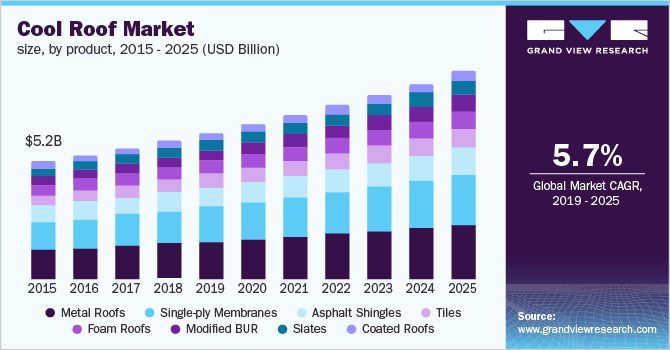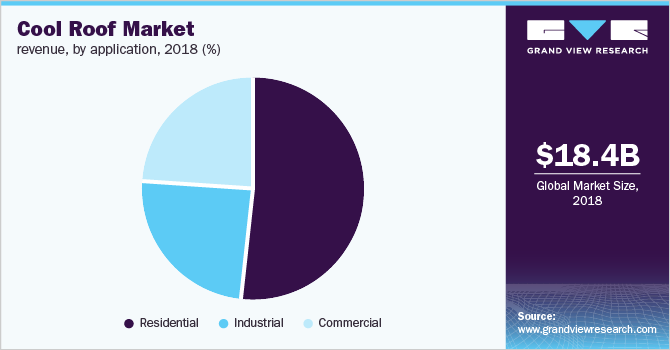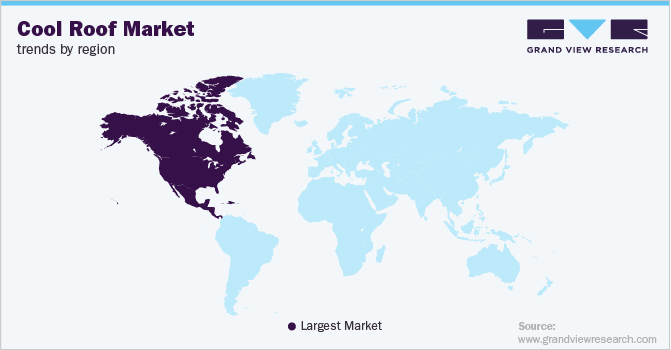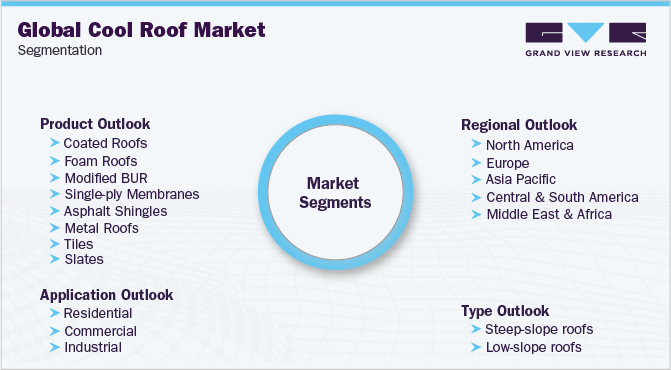- Home
- »
- Green Building Materials
- »
-
Cool Roof Market Size & Share, Industry Report, 2019-2025GVR Report cover
![Cool Roof Market Size, Share & Trends Report]()
Cool Roof Market (2019 - 2025) Size, Share & Trends Analysis Report By Roof Type (Steep Slope, Low Slope), By Product (Single-ply Membranes, Asphalt Shingles, Metal Roofs, Coated Roofs), By Application, And Segment Forecasts
- Report ID: GVR-3-68038-504-5
- Number of Report Pages: 110
- Format: PDF
- Historical Range: 2014 - 2017
- Forecast Period: 2019 - 2025
- Industry: Advanced Materials
- Report Summary
- Table of Contents
- Segmentation
- Methodology
- Download FREE Sample
-
Download Sample Report
Report Overview
The global cool roof market size to be valued at USD 27.1 billion by 2025 and is expected to grow at a compound annual growth rate (CAGR) of 5.7% during the forecast period. Rapid growth in the global construction industry and increasing emphasis on green building projects are anticipated to drive the demand for cool roofs and, in turn, propel the market growth over the forecast period.

Growth in the construction industry on account of rapid urbanization, removal of trade barriers for foreign investments, and increasing spending by the global construction companies in potential markets are various factors that are expected to drive the demand for new roofing systems such as cool roofing products across the globe over the forecast period. Recent growth in the infrastructure sector in countries, such as Australia, India, Germany, Norway, Sweden, and Canada, is anticipated to augment the product demand. Furthermore, the global refugee crisis and the requirement for infrastructure expansion in developing countries are expected to propel the demand for the product globally over the forecast period.
The market in the U.S. is expected to witness growth owing to the growing interest of businesses and homeowners to install cool roofs made from durable roofing materials, which are resistant to damages caused by hailstorms, uplifts due to high winds, and exposure to solar radiations. Cool roofs help avert future occurrences of heat island effects. Cool roofing is an emergent technology that is used to control the temperature of buildings. It prevents the absorption of heat by reflecting sun rays and emitting the UV radiations back to the atmosphere, thereby maintaining the indoor ambient temperature.
Leadership in Energy and Environmental Design (LEED) is a popular green building certification program worldwide. It evaluates construction projects based on design, construction, operations, and maintenance, which contributes to the sustainable development of buildings. Rising importance of energy conservation and strict environmental regulations are, therefore, anticipated to be the major driving factors triggering the growth of cool roof market over the forecast period.
Cool Roof Market Trends
The rising population and increase in global warming are boosting the demand for market. Several countries are focusing on energy conservation systems like cool roofs. Cool roofs absorb less heat from the sun than traditional roofs and are environment-friendly. By reducing local air temperatures, cool roofs can help to reduce the urban heat island effect as well as can help in reducing peak energy demand and power plant emissions such as carbon dioxide, nitrous oxides, sulfur dioxide, and mercury. This can help prevent power failures and reduce power plant pollution. All these advantages offered by cool roofs are expected to drive market growth during the forecast period.
In the agricultural sector, cool roofs are useful because they retain sunlight while emitting no heat and this preserves the nutritional richness of the crops. As a result, in the roofing industry, cool roofing solutions are gradually overtaking traditional roofing systems. Duringthe forecast period, this aspect is expected to boost the industry growth rate.
The raw material costs for cool roofs are extremely high and the market is further limited by the high expense of maintenance and repair that is required to maintain its longevity. Furthermore, many building companies and builders have avoided implementing cool roof solutions in recent years because of the associated high costs. As a result, the manufacturer's capacity to supply low-cost roofing materials is limiting the market growth during the forecast period.
Roof Type Insights
Cool roofs are categorized into two major types, namely steep-sloped and low-sloped. Steep slope type comprises an inclined roofline and is majorly used in residential buildings, whereas low sloped is mostly installed in commercial and industrial buildings. Depending on the design of a building and structural components, various techniques are used for steep-sloped and low-sloped roofs.
Materials used in the construction of steep-sloped roofs include tiles, metal roofing, and asphalt shingles. Furthermore, the roofs contribute to over 40% of the exterior appearance of the building, and, therefore, the type of material used in the construction of these roofs such as tiles and shingles demands higher aesthetic value.
Roofing materials such as coated, foam, built-up roofing systems, modified bitumen, and single-ply membranes are used in the construction of low-sloped systems. Low-sloped segment accounts for a significant market share on account of its ability to reflect more solar energy into the atmosphere as compared to steep-sloped roofs
The installation cost of steep-sloped systems is high as compared to low sloped on account of the complexity of the process associated with the former. However, inclined roofs prevent the accumulation of dirt as water easily washes the dirt and debris from the surface, therefore, it requires less maintenance, which, in turn, is likely to boost the demand for steep-sloped systems over the forecast period.
Single-ply membranes or coatings are installed directly on top of the existing roofing assembly, which reduces the installation cost of the product. Moreover, repair and maintenance cost of low-sloped systems is low as they are installed on a flat surface, which offers negligible or minimal resistance, thereby driving the product demand over the forecast period.
Product Insights
Single-ply membranes accounted for 23.4% of the total revenue share of the market in 2018 on account of their waterproof, flexible, and durable characteristics. Single-ply Ethylene Propylene Diene Monomer (EPDM) is widely used in the roofs of commercial buildings owing to high flexibility offered by the product under diverse climatic conditions.
Solar reflectance of asphalt shingles is low on account of the presence of a limited quantity of pigment in granule coating coupled with the rough texture of the product, which results in multiple scattering of the sunlight, thus resulting in less reflection. Therefore, the application of asphalt shingles as cool roofs is limited to residential buildings and a few commercial buildings.
The availability of metal systems in a variety of substrates, textures, and colors provides customization options to customers, which is likely to drive their popularity and boost their demand over the forecast period. Furthermore, low life-cycle cost, low weight, and fire-resistance ability of metal roofs are likely to have a positive impact on the market growth over the forecast period.
White-coated roofs are more efficient as they reflect over 70% to 80% of the sunrays, whereas pigmented coated ones that are available in darker shades, such as blue, green, and red, are less efficient and reflect less than 20% of the sunrays. The demand for pigmented coated variant in residential buildings is witnessing significant growth rate on account of their ability to impart additional aesthetic value to the structures.
Application Insights
Based on application, the market has been segmented into residential, commercial, and industrial. Cool roofs provide comfort to the occupants of a building by keeping the building cooler during hot summer months on account of properties such as high thermal emittance (TE) and solar reflectance (SR). In addition, a longer lifespan compared to standard roofs is expected to drive their demand over the forecast period.
Growing awareness of consumers about the benefits offered by cool roofs such as increased energy efficiency by reducing heat gain due to the reflection of sun rays back into the atmosphere, which reduces the usage of air conditioners is expected to drive the demand for cool roofing products in residential applications over the forecast period.

The use of cool roofs in commercial buildings is anticipated to reduce heat flow from outside into building interiors, thereby, reducing electricity requirements for space cooling or air-conditioning. In addition, since the cost of electricity for commercial spaces is relatively high, the installation of cool roofs aids in cost saving owing to low-energy requirement. The product helps decrease the strain on electrical grid, thereby reducing the risk of power outages, enabling continuous workflow, and increasing the efficiency of industrial buildings. In addition, regulations on the construction of green buildings and rising awareness regarding green buildings are anticipated to drive their demand in industrial building applications over the forecast period.
Regional Insights
The product is installed based on the suitability of cool roofing systems in a particular region. Some regions require less insulation, whereas in some regions, local codes can allow a fluctuation in insulation when a cool roof is installed. The maximum benefits of energy-saving can be obtained through a combination of reflective and insulation systems in different regions.

High product penetration in the U.S. can be attributed to an increasing number of large-scale infrastructure investment projects including hotels and hospitals in New York, Missouri, and Los Angeles. Rising demand for the expansion of floor space in various industries has led to a growth in new construction and renovation projects, thereby, driving the product demand.
Emerging economies of Asia Pacific are witnessing high growth in construction spending and increasing consumer disposable income owing to rapid urbanization. In addition, infrastructure renewal projects and ongoing efforts to build megacities are likely to drive the demand for advanced systems such as cool roofing products.
North America is expected to account for a revenue share of 42.0% in 2018 on account of the growing construction industry and renovation activities in the U.S. In addition, increasing adoption of the products to maintain indoor temperatures in North American countries is likely to drive the demand over the forecast period.
Key Companies & Market Share Insights
The market is marked by the presence of large-scale and small-scale manufacturers across the globe, thereby resulting in a moderate level of concentration. Competition in the market is intense and categorized by the need for reliable and innovative cool roofing solutions. Majority of manufacturers strive to use innovative and suitable technologies to offer durable products. Major players in the market compete based on product application techniques and product innovation.
Recent Development
In June 2022, Owens Corning successfully acquired WearDeck® which is located at Ocala, Florida- a manufacturer of quality composite decking and structural lumber. WearDeck® solutions will allow Owens Corning to reposition its composites business to focus on high value material solutions in the building and construction industry. This acquisition will benefit Owens Corning to achieve revenue worth USD 10 billion by the year 2024, thus fueling the market growth.
Some of the prominent players in the cool roof market include:
-
Owens Corning
-
GAF
-
CertainTeed Corporation
-
Tamko Building Products, Inc.
-
IKO Industries Ltd.
-
ATAS International Inc.
-
Henry Company
Cool Roof Market Report Scope
Report Attribute
Details
Market size value in 2020
USD 21.4 billion
Revenue forecast in 2025
USD 27.1 billion
Growth Rate
CAGR of 5.7% from 2019 to 2025
Base year for estimation
2018
Historical data
2014 - 2017
Forecast period
2019 - 2025
Quantitative units
Volume in million square feet, revenue in USD million and CAGR from 2019 to 2025
Report coverage
Revenue forecast, company ranking, competitive landscape, growth factors, and trends
Segments covered
Roof type, product, application, region
Regional scope
North America; Europe; Asia Pacific; Central & South America; Middle East; Africa
Country scope
U.S.; Canada; Mexico; Germany; U.K.; France; Russia; Spain; Italy; China; India; Japan; South Korea; Australia; Brazil; Argentina; United Arab Emirates
Key companies profiled
Owens Corning; GAF; CertainTeed Corporation; Tamko Building Products, Inc.; IKO Industries Ltd.; ATAS International Inc.; Henry Company
Customization scope
Free report customization (equivalent up to 8 analysts working days) with purchase. Addition or alteration to country, regional & segment scope.
Pricing and purchase options
Avail customized purchase options to meet your exact research needs. Explore purchase options
Global Cool Roof Market SegmentationThis report forecasts revenue growth at global, regional, and country levels and provides an analysis on the industry trends in each of the sub-segments from 2014 to 2025. For the purpose of this study, Grand View Research has segmented the global cool roof market report on the basis of roof type, product, application, and region.

-
Roof Type Outlook (Volume, Million Square Feet; Revenue, USD Million, 2014 - 2025)
-
Steep-slope roofs
-
Low-slope roofs
-
-
Product Outlook (Volume, Million Square Feet; Revenue, USD Million, 2014 - 2025)
-
Coated Roofs
-
Foam Roofs
-
Modified BUR
-
Single-ply Membranes
-
Asphalt Shingles
-
Metal Roofs
-
Tiles
-
Slates
-
-
Application Outlook (Volume, Million Square Feet; Revenue, USD Million, 2014 - 2025)
-
Residential
-
Commercial
-
Industrial
-
-
Regional Outlook (Volume, Million Square Feet; Revenue, USD Million, 2014 - 2025)
-
North America
-
The U.S.
-
Canada
-
Mexico
-
-
Europe
-
Germany
-
U.K.
-
France
-
Russia
-
Spain
-
Italy
-
-
Asia Pacific
-
China
-
India
-
Japan
-
South Korea
-
Australia
-
-
Central & South America
-
Brazil
-
Argentina
-
-
Middle East & Africa
-
South Africa
-
United Arab Emirates
-
-
Frequently Asked Questions About This Report
b. The global cool roof market size was estimated at USD 19.9 billion in 2019 and is expected to reach USD 21.4 billion in 2020.
b. The global cool roof market is expected to grow at a compounded annual growth rate of 5.7% from 2019 to 2025 to reach USD 27.1 billion in 2025.
b. North America dominated the cool roof market with a share of 43.6% in 2019. Increasing adoption of the products to maintain indoor temperatures in North American countries is likely to drive the demand over the forecast period.
b. Some key players operating in the cool roof market include Owens Corning; GAF; CertainTeed Corporation; Tamko Building Products, Inc.; IKO Industries Ltd.; ATAS International Inc.; and Henry Company.
b. Key factors driving the cool roof market growth include rapid growth in the global construction industry and increasing emphasis on green building projects.
Share this report with your colleague or friend.
Need a Tailored Report?
Customize this report to your needs — add regions, segments, or data points, with 20% free customization.

ISO 9001:2015 & 27001:2022 Certified
We are GDPR and CCPA compliant! Your transaction & personal information is safe and secure. For more details, please read our privacy policy.
Trusted market insights - try a free sample
See how our reports are structured and why industry leaders rely on Grand View Research. Get a free sample or ask us to tailor this report to your needs.










